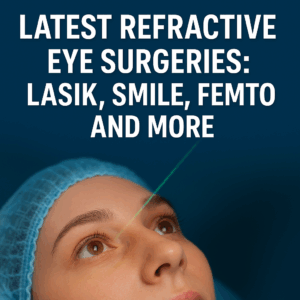
Anushka Super Speciality Eye Hospital
Call: 90044 44422 / 99213 44422 | Timings : 8.30 a.m to 5.30 p.m (Mon-Sat) | Add: Shri Swami Samarth Soc, Kaneri Dhamankar Naka, Bhiwandi




Accredited for Quality Care
Understanding Squint (Strabismus): Causes, Types, Treatment, and FAQs
anushka
13 June 2025
What is Eye Squint (Strabismus)?
Squint, medically known as strabismus, is a condition in which the eyes do not align properly. While one eye looks straight ahead, the other may turn inwards, outwards, upwards, or downwards. This misalignment can occur occasionally or be constant, and it may affect one or both eyes.
Squinting can be more than a cosmetic concern—it often indicates an underlying visual problem and, if left untreated, may result in lazy eye (amblyopia) or permanent vision loss in children.
Causes of Squint
Squint can be congenital (present at birth) or acquired later in life due to various reasons. Here are the most common causes:
- Congenital (Infantile) Squint: Develops in the first 6 months of life.
- Refractive Errors: Especially hypermetropia (farsightedness) in children.
- Neurological Causes: Brain or nerve damage due to trauma, stroke, or tumor.
- Muscular Problems: Dysfunction of the eye muscles or their nerve supply.
- Systemic Conditions: Such as thyroid eye disease or diabetes.
- Injury: Trauma to the eye or head.
- Hereditary Factors: Family history of squint increases the risk.
Types of Squint
Squint is broadly classified based on direction, constancy, and cause:
1. Based on Direction of Eye Deviation:
- Esotropia (Convergent Squint): Eye turns inward.
- Exotropia (Divergent Squint): Eye turns outward.
- Hypertropia: Eye turns upward.
- Hypotropia: Eye turns downward.
2. Based on Constancy:
- Constant Squint: The misalignment is always present.
- Intermittent Squint: Occurs occasionally, often during fatigue or illness.
3. Based on Age of Onset:
- Congenital Squint: Present at birth or develops within 6 months.
- Acquired Squint: Develops later due to trauma, neurological issues, or other health conditions.
4. Other Classifications:
- Comitant Squint: Angle of deviation remains the same in all directions.
- Incomitant Squint: Angle varies depending on the gaze direction.
Symptoms of Squint
The symptoms vary depending on the type and severity of the squint. Common signs include:
- Misalignment of eyes
- Double vision (diplopia)
- Difficulty focusing or reading
- Head tilting or turning
- Eye strain or headaches
- Closing or covering one eye in bright light
- Poor depth perception
- Lazy eye (amblyopia) in children
Diagnosis of Squint
An eye specialist (ophthalmologist or optometrist) will perform a detailed eye examination including:
- Visual acuity test
- Cover/uncover test
- Refraction test to detect glasses prescription
- Corneal light reflex test
- Ocular motility test to check eye muscle function
- Dilated fundus examination to rule out retinal or neurological issues
For children, early screening is essential as squint is more effectively treated when diagnosed early.
Treatment for Squint
Treatment depends on the type, severity, and underlying cause of the squint. The main goal is to align the eyes and restore binocular vision. Here are the common treatment options:
1. Glasses
Corrective lenses help align the eyes, especially in cases of refractive squint due to hypermetropia.
2. Patching (Occlusion Therapy)
Used to treat amblyopia, this involves covering the stronger eye to encourage use of the weaker eye.
3. Vision Therapy
Non-surgical method involving exercises to improve eye coordination, focusing, and tracking skills.
4. Prism Lenses
These special lenses can help manage double vision and minor deviations.
5. Botulinum Toxin Injection (Botox)
Used in selected adult cases or small-angle squints. It temporarily weakens the overacting muscles.
6. Squint Surgery
Surgical correction is done by tightening or loosening specific eye muscles. It is usually an outpatient procedure and may require more than one operation for complete correction.
7. Neurological Management
If the squint is due to a nerve palsy or brain condition, neurological treatment may be necessary in coordination with eye therapy.
Prognosis
When detected early and treated promptly, squint can be effectively managed. Children have a higher chance of recovery with early intervention. In adults, cosmetic and functional outcomes vary depending on the underlying cause.
Can Squint Be Prevented?
While not all squints can be prevented, early eye exams in infants and toddlers help detect issues early. Managing conditions like diabetes, thyroid disease, and avoiding eye injuries can also reduce the risk.
Frequently Asked Questions (FAQs) About Squint
Q1. Can squint be treated without surgery?
Yes, in many cases, especially in children, squint can be managed with glasses, vision therapy, and occlusion therapy. Surgery is recommended only if conservative treatments fail.
Q2. Is squint hereditary?
Yes, squint can run in families. Children with a family history should undergo regular eye exams.
Q3. At what age is squint surgery performed?
Squint surgery can be done as early as 6 months of age if needed, but most surgeries are performed after age 1–2 when amblyopia and refractive errors are managed.
Q4. Can adults undergo squint surgery?
Yes, adults can benefit from squint surgery for both cosmetic and functional reasons, including relief from double vision.
Q5. Does squint always result in lazy eye (amblyopia)?
Not always, but it is a significant risk if untreated, especially in young children. Early treatment can prevent amblyopia.
Q6. Can squint come back after treatment?
Yes, recurrence is possible, particularly if the underlying cause persists or in congenital cases. Regular follow-up is crucial.
Q7. Is it normal for newborns to appear cross-eyed?
Some babies may have temporary misalignment in the first 2–3 months. If it persists beyond 6 months, an eye exam is recommended.
Conclusion
Squint or strabismus is more than just an eye misalignment—it can affect a person’s vision, appearance, and self-confidence. The key to successful management lies in early diagnosis and timely treatment. If you notice any signs of squint in yourself or your child, consult an eye care professional immediately. Whether through glasses, therapy, or surgery, modern ophthalmology offers effective solutions to restore proper eye alignment and visual function.
Recent Posts


